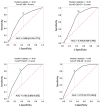Pain and Coping Strategies as Determinants of Malnutrition Risk in Lung Cancer Patients: A Cross-Sectional Study
- PMID: 39064636
- PMCID: PMC11279586
- DOI: 10.3390/nu16142193
Pain and Coping Strategies as Determinants of Malnutrition Risk in Lung Cancer Patients: A Cross-Sectional Study
Abstract
Progressive cachexia and malnutrition severely impact the physical and mental condition of cancer patients. Pain is a prognostic factor for shorter survival in cancer patients, and coping strategies are crucial for adapting to treatment and dietary regimens. This study assessed pain levels, pain-related beliefs, and coping strategies as factors increasing malnutrition risk in 257 lung cancer patients. Sociodemographic and clinical data were collected from medical records. The Mini Nutritional Assessment (MNA), Visual Analog Scale (VAS), Beliefs about Pain Control Questionnaire (BPCQ), and Coping Strategies Questionnaire (CSQ) were used. Overall, 42.8% of patients were at risk of malnutrition, and 17.5% were malnourished. Nutritional status negatively correlated with CSQ domains: reinterpretation of pain (RP: rho = -0.194; p = 0.002), catastrophizing (CP: rho = -0.414; p = 0.001), ignoring pain (IP: rho = -0.198; p = 0.001), praying/hoping (PH: rho = -0.253; p < 0.001), and coping self-statements (CS: rho = -0.172; p = 0.006); and BPCQ domains: the power of doctors (PD: rho = -0.196; p = 0.002) and VAS (rho = -0.451; p < 0.001). Nutritional status positively correlated with CSQ domains: pain control (PC: rho = 0.499; p < 0.001) and the ability to reduce pain (AR: rho = 0.512; p < 0.001). In multivariate regression analysis, a better nutritional status was associated with a younger age (β = -0.094; p < 0.001), non-small-cell lung cancer (NSCLC) (β = 1.218; p = 0.037), a greater ability to reduce pain (CSQ-AR) (β = 0.901; p < 0.001), lower catastrophizing (CSQ-CP) (β = -0.165; p = 0.001), and lower pain perceived (VAS) (β = 0.639; p < 0.001). Statistical analyses included Spearman's correlation and multivariate regression with a significance level of p < 0.05. Patients with a normal nutritional status had reduced doctor involvement in pain control, less frequent negative coping strategies, and more common positive coping strategies. A normal nutritional status correlates with lower perceived pain. A better nutritional status is linked to a younger age, NSCLC, lower pain levels, greater pain reduction ability, and lower scores in pain catastrophizing.
Keywords: coping strategies; lung cancer; malnutrition; pain control; pain level.
Conflict of interest statement
The authors declare no conflicts of interest.
Figures






References
-
- Gouez M., Delrieu L., Bouleuc C., Girard N., Raynard B., Marchal T. Association between Nutritional Status and Treatment Response and Survival in Patients Treated with Immunotherapy for Lung Cancer: A Retrospective French Study. Cancers. 2022;14:3439. doi: 10.3390/cancers14143439. - DOI - PMC - PubMed
MeSH terms
LinkOut - more resources
Full Text Sources
Medical
Research Materials
Miscellaneous

